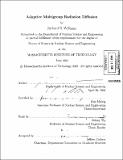Adaptive multigroup radiation diffusion
Author(s)
Williams, Richard B., Sc. D. Massachusetts Institute of Technology
DownloadFull printable version (8.295Mb)
Other Contributors
Massachusetts Institute of Technology. Dept. of Nuclear Engineering.
Advisor
Kim Molvig.
Terms of use
Metadata
Show full item recordAbstract
This thesis describes the development and implementation of an algorithm for dramatically increasing the accuracy and reliability of multigroup radiation diffusion simulations at low group counts. This is achieved by allowing the energy group boundaries to move in energy space as the simulation evolves. This adaption in energy space effectively removes the sensitivity of multigroup diffusion to group boundary placement and makes the technique a viable option for large, computationally expensive computer simulations. Traditional multigroup radiation diffusion solvers break down at small group counts because of the coarse discretization of highly nonlinear material opacity. Small changes in the group boundary energies can lead to wildly different mean opacities and therefore significant changes in simulation output. This sensitivity has rendered the technique unpredictable and it is generally considered to be not worth the added computational expense. Unfortunately, multigroup diffusion is the only method available for adding frequency dependence to the radiation field in a standard diffusion solver. When attempting to model a system that includes a non-equilibrium radiation field, frequency-dependent effects become important. (cont.) While running multigroup simulations with large numbers of groups is a reliable method for obtaining increased accuracy over grey diffusion, the computational expense scales linearly with the number of groups. For large simulations, running multigroup diffusion with increased group counts is infeasible and running with small group counts is unreliable. This has led to a tendency to use grey diffusion even in environments where the radiation field is known to be out of equilibrium with the material. This thesis includes a new derivation of the diffusion equation and an overview of traditional "static" multigroup radiation diffusion along with an analysis of its shortcomings. The sensitivity due to group boundary placement for small numbers of groups is shown. Data are presented which demonstrate that small group count multigroup calculations can actually provide a worse answer than grey diffusion. A system is developed and implemented for allowing the multigroup energy boundaries to "adapt," or move in energy space, as the simulation evolves as well as a method for determining where increased energy resolution is needed for an arbitrary set of material opacities. By adapting in energy space, the sensitivity of multigroup diffusion to group boundary placement is ameliorated. (cont.) Data are presented that demonstrate a reliable increase in accuracy for adaptive multigroup diffusion as the number of groups is increased-even at very small group counts. Furthermore, the data show that the level of accuracy obtained with the adaptive multigroup approach is equivalent to or better than the best-case data obtained with the static multigroup approach. This result is more profound than a simple increase in accuracy-the increased reliability makes multigroup radiation diffusion a viable tool for large non-equilibrium simulations. Users are no longer forced to use the grey diffusion method which is known to be physically inadequate. Furthermore, users are finally free to incorporate a frequency-dependent treatment of radiation without the accuracy ambiguities of standard multigroup diffusion.
Description
Thesis (Sc. D.)--Massachusetts Institute of Technology, Dept. of Nuclear Engineering, 2005. Includes bibliographical references (p. 189-193).
Date issued
2005Department
Massachusetts Institute of Technology. Department of Nuclear Engineering; Massachusetts Institute of Technology. Department of Nuclear Science and EngineeringPublisher
Massachusetts Institute of Technology
Keywords
Nuclear Engineering.